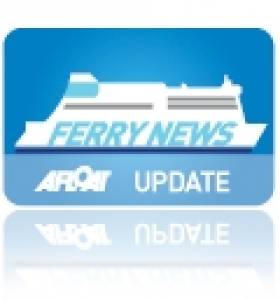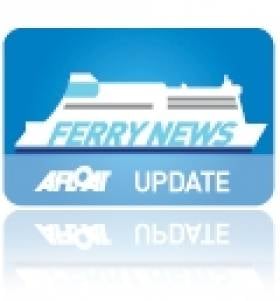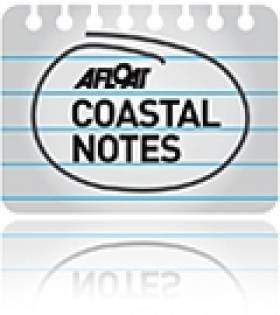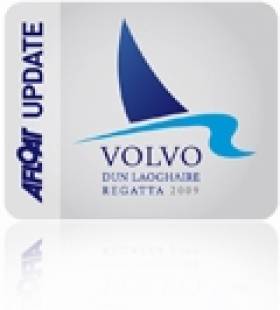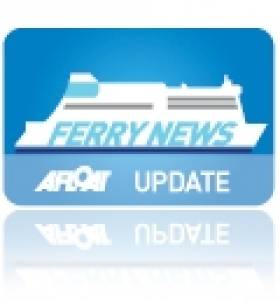Displaying items by tag: irish sea
ISORA Entry List 2011
Up to 40 yachts form the backbone of the Irish Sea Offshore Racing Association fleet (ISORA). Although the 2011 entry list (below) shows a large number of Beneteau models it also reveals a wide range of other marques, largely between 30 and 50 foot. Prominent types are J109s, Sigma 33s and a number of Jeanneau yachts too.
ISORA 2011 Racing Fleet
| Boat Name | Sail no | Hull / Mast Col | Model |
| Lancastrian | GBR7682T | White | Starlight |
| Yahtzee | IRL 1068 | White/Gold | Oceanis 41 |
| Rebellion | IRL 6001 | Blue/Silver | Nicholson 58 |
| Miss Scarlett | IRL 4763 | White/Gray | Sunfast 40.3 |
| Orna | IRL532 | Blue | 40C |
| Mistral of St Helier | K8337 | White | 3800D |
| Poppy | GBR4183 | Red/White | Contention 33 |
| Dinah | IRL 3508 | White/Aluminium | Jeanneau |
| Raging Bull | IRL 9666 | White/Silver | Sigma 400 |
| Tsunami | IRL 4007 | Grey/Silver | First 40.7 |
| GFT Adventurer | GBR 23161 | White/Silver | First 45 |
| Jedi | IRL 8088 | J109 | |
| English Mick | GRB 4771R | Blue/Silver | First 47.7 |
| Galileo | IRL1944 | Blue | First 47.7 |
| Lula Belle | IRL3607 | White | Beneteau 36.7 |
| Finnigans Wake | IRL2008 | White | 37B |
| Obsession | IRL 4513 | White/Aluminium | Sigma 3300 |
| Katanca | IRL 31310 | White/Aluminium | Elan 31 |
| Just Enough | GBR6912T | J92 | |
| Big Hillie Style | IRL 3208 | White | Sun Fast 3200 |
| Adelie | FRA 9631 | White/Black | First 34.7 |
| Mojito | IS 36L | White/Aluminium | Bavaria |
| Calypso | IRL 5643 | White/Silver | Oceanis E51 |
| Legally Blonde | IRL 3175 | Grey/Aluminium | Beneteau |
| GWAWR | GRB 8330 | White/Aluminium | Sigma |
| First of September | IRL 8581 | White/Silver | First 435 |
| Rollercoaster | IRL 9109 | White/Aluminium | J109 |
| Quite Correct | IRL 5405 | White/White | Jeanneau D5 54 |
| Sarnia | IRL 2260 | White/Gold | 36 |
| Sailing West Intuition | GBR 9383R | Blue/Aluminium | Reflex 38 |
| Sailing West One Life | GBR 3708R | White/Silver | Sunfast 37 |
| Temper Tantrum | 6909T | White | 40 |
| Wennol 3 | GBR1347R | White/Black | First 34.7 |
| African Challenge | IRL 2649 | White/Silver | Fast |
| Windshift | IRL37737 | White/Aluminium | Sunfast 37 |
| Oystercatcher | IRL 1177 | White/ Silver | Gib'sea 37 |
| Aztec 3 | IRL29832 | White/Silver | A35 |
17 Boats to Contest First ISORA Offshore of the Season
There are 17 definite entries and it is estimated up to another half a dozen could be sailing to the line next Saturday morning for the first race of the 2011 ISORA series.
The impressive early entry follows a series of offshore sailing talks held at the National Yacht Club earlier this month.
Click this link for the latest ISORA news.
The 57-mile course across the Irish Sea from Dun Laoghaire on the Irish east coast to Holyhead in Wales will be decided on the morning of the race at the National Yacht Club and transmitted by VHF on 37 for the first offshore race of 2011.
Last year's overall champion, Raging Bull, a Sigma 400, from Skerries and skippered by Matt Davies is slated as a possible contender.
ISORA Chief Peter Ryan has issued sailing Instructions as follows:
2011 Sailing Instructions
Supplementary Information
Race 1 Dun Laoghaire - Holyhead
Sailed under the burgee the National Yacht Club
Saturday 30th April 2010
TIME OF START FOR ALL CLASSES
07.55 Warning signal - Class flags (Numerals 1 & 2) hoisted
07.56 Preparatory Signal - Blue Peter hoisted
07.59 Blue Peter down
08.00 Start – Class flags down
The start may be broadcast on VHF Channel 37 (M1)
STARTING LINE
The start line shall be located in Scotsman's Bay between the DBSC 'Pier' mark and an adjacent committee boat that may be using engine power to hold station. This changes RRS 62.1(a).
THE COURSE (57 miles approx)
1. STARTING LINE
2. KISH Lighthouse (S)
3. M2 Buoy (S) 53 28.8N 5 25.5W
4. FINISH LINE
FINISH LINE
The finish line shall be between the end of the Holyhead breakwater and the Clippera Buoy – 0.6
miles off pier head, bearing 067(T).
Boats approaching the finish should contact "ISORA Finisher" on VHF Channel 37 (M1) when 1 hour
from the finish and again at 10 minutes from the finish. Please note that the finisher will only have a
handheld radio and you may not receive an acknowledgment to the first contact.
The finish time and the time due North of M2 should be recorded in the log by each boat and text to
ISORA at 00353 87 2545037 as soon as possible after the race as a Declaration.
RETIREMENTS
Telephone National Yacht Club 00353 1 2805725 and text ISORA 00353 87 2545037
For safety it is recommended to also inform the coastguard
NOTES
1. Keep a close lookout for commercial traffic when entering or exiting Dun Laoghaire and
Holyhead. The Stena HSS in particular can be hard to spot from behind the breakwater.
2. The time of crossing the finish line should be noted in the log.
3. Dinner will be available at Holyhead Sailing Club on Saturday evening. Phone No. 0044 1407
762526
4. Berthing in Holyhead Marina can be arranged. Phone 0044 1407 764242
Former US Navy Fast-Craft Re-opens Seasonal Dublin Route
Manannan's chequered career included a five year charter initially to the United States Navy but transferred to the United States Army Forces between 2001-2006. The 5,029grt craft (see photo) was used for various trials and demonstrations and in which saw service in the Persian Gulf in support of 'Operation Iraqi Freedom' and in 2003 'Operation Enduring Freedom' in the Horn of Africa.
An engine plant of 4 x Caterpillars diesel generates a speed of over 40 knots / 46 mph which provided logistical solutions by the High-Speed Vessel (HSV) to transport troops and supplies covering long distances in support of the Combined Joint Task Force.
Other tasks required by the force included the roles of operating as a mobile command centre which entailed working closely inshore and operating as a helicopter carrier. Helicopters landed at the craft's stern positioned helicopter landing deck.
The military role of the craft is in stark contrast compared to when the 96m ferry was launched in 1998 for civilian purposes as the Incat 050, the number representing the number of pioneering wave-piercing craft built by InCat in Hobart, Tasmania.
Asides her military days the 800-passenger / 200 vehicle fast-ferry has served the Hobart-Melbourne route, between New Zealand's north and south island and in European waters in the Mediterrean and to the Canary Islands.
Manannan (see photo) entered service last May after the Isle of Man Steam Packet Company (IOMSPco) purchased the vessel which was laid-up in Hobart. She made the long delivery to the northern hemisphere and was re-converted for ferry usesage during a refit in Portsmouth.
The 181 year-old company is the only sea-based passenger operator to the island on services linking Dublin, Belfast, Heysham, Liverpool and (Birkenhead) in the winter months.
There are rival companies such as the Ramsey Steamship Company but they are freight-only operators mostly running to Belfast and Liverpool using short-sea coastal traders and to other small Irish Sea ports.
An annual round island cruise is held and like last year the Manannan will be serving the cruise on Sunday 1 May departing Douglas at 11am for a journey of around 2 hours. The route closely circumnavigates the spectacular Manx coastline. For information on the island cruise and fares click here.
Ulysses Celebrates 10 Years of Irish Sea Service
In January 2000 the keel of the worlds largest car ferry was laid at the Aker Finnyards in Rauma, Finland. The following year the €100m cruiseferry giant departed the shipyard on a four-day delivery voyage to Dublin Port. Upon Ulysses's arrival on 4th March she was presented with a traditional welcoming escort of saluting water-firing tugs.
The Ulysses was named at a ceremony in the port on 21st March by the 'golden godmother' Mairead Berry, Ireland's 25-year old Paralympic Games gold medallist. Four days later Ulysses made her commercial maiden voyage to Holyhead on 25th March.
Wih 12 decks the vessel has an extensive range of facilities and they are named with themes derived from James Joyce's famous novel 'Ulysses'. There is seating available for up to 1,938 passengers and there are 117 twin or single-cabins, accommodating up to 228 passengers.
Only two months into service the Ulysses won the prestigious 'Most Significant New Build - Ferry' category award in the Cruise & Ferry magazine 2001 Awards competition. Her Finnish builders are not only builders of large cruise-ferries for Baltic Sea operators and beyond but also are also renowned for the construction of very large cruiseships for international clients.
Ulysses was designed specifically to serve the central corridor route with a schedule of two round trips daily. She directly replaced the 1997 Dutch built 34,031 grt ro-pax Isle of Inishmore, which transferred to Rosslare-Pembroke Dock service.
In 2006 the Ulysses alongside her fleetmates were transferred from the Irish flag to the Cypriot flag in addition to a change of Irish crew with those outsourced from citizens mostly from the Baltic and Eastern European countries.
Due to the sheer size of the Ulysses, which has a length of 209m, a beam of nearly 32m and a 6.4m draught, she has not missed a single crossing due to bad weather conditions. The vessel has a 22 knot / 41kph service -speed on the 60-mile route which translates to a distance of over 182,000 kms a year.
To celebrate Ulysses 10th year in service, Irish Ferries has enhanced the Club Class option to passengers which includes free-Wifi, which enables a constant connection and an array of other benefits during the 3-hour 15 minute crossing.
For a virtual tour of the Ulysses with views taken from the top deck as the cruiseferry departs Holyhead and the mountains of Snowdonia setting as a backdrop plus interior tours of the vessel click here.
Irish Authorities Approve Stena / DFDS Merger
Of the two services, the Belfast-Liverpool (Birkenhead) is for passengers and freight while the and Belfast-Heysham port route is exclusively for freight-only users. To read more about the decision from the authority click here.
In February the UK's Office of Fair Trading (OFT) referred Stena AB's acquisition from DFDS A/S to the Competition Commission, conclusions on the report are not expected to be made until 25 July. To read more about the merger click here.
In the meantime the Belfast-Liverpool (Birkenhead) route continues trading under the name of Stena Line Irish Sea Ferries Ltd which is separately operated to Stena Line's other Irish Sea routes.
Sailings on the 8-hour route are run by the Italian built 27,510 tonnes ro-pax twins Lagan Seaways and Mersey Seaways which have been in service since the newbuilds were launched in 2005.
As the acquisition remains subject to regulatory clearance, passengers intending to travel on the route can continue to make bookings through the DFDS Seaways website by logging onto this link.
In addition the acquisition involved the sale of the South Korean built freight-ferries Hibernia Seaways and Scotia Seaways which operate Belfast-Heysham sailings.
Irish Sea 'Racehorse' Returns
Dawn Merchant and Brave Merchant represented the first pair of the 'Racehorse' class quartet of ro-pax sisters commissioned for the Cenargo Group. The quartet were built by Spainish shipbuilders Astilleros Espanoles SA in Seville, noting the first pair at 22,046grt where slightly smaller in tonnage terms compared to their 22,215grt counterparts Midnight Merchant and Northern Merchant. Upon delivery in 2000 the second pair were chartered to Norfolkline's Dover-Dunkerque route.
With a 130 truck capacity the Norman Trader can handle a marginally higher number of freight vehicles compared to the Norcape which handled 127 trucks. The Norcape, a 32-year-old freight-only vessel,was stood down in February and remains laid-up at Liverpool's Huskisson Dock. Incidentally, Norman Trader has joined one of her Racehorse class sisters, European Endeavour (formerly Midnight Merchant) which had directly replaced the Norcape on the central corridor route.
Likewise the European Endeavour is no stranger to the Irish route as for the last two years she has acted as winter relief vessel to cover the refits of the routes Dutch built ro-pax sisters Norbay and Norbank. The latter vessel is now undergoing a refit by Cammell Laird Shiprepairers in Birkenhead, now that the Norman Trader is in service to maintain the three-ship operated 8-hour route.
The Norman Trader had arrived into Dublin Bay last Friday from London's Tilbury Docks, on the next day she entered Dublin Port. In recent years she has operated on English Channel routes for the French shipping giant Louis-Dreyfus Armateurs through their ferry division LD Lines.
Norman Trader's (Dawn Merchant) sister Brave Merchant now renamed Norman Bridge also runs for LD Lines 'Motorways of the Seas' (MOS) route across the Bay of Biscay between Nantes /St. Nazaire to Gijón in northern Spain. The 14-hour route which started last year, which was run iniatially as a joint venture between Grimaldi Lines and Louis-Dreyfus and traded as GLD Atlantique.
- Dublin Port
- Bay of Biscay
- irish sea
- Ports and Shipping News
- Birkenhead
- Norcape
- RoPax
- DublinLiverpool
- Norfolkline
- FreightFerry
- Motorways of the Sea
- Norbank
- Norbay
- MOS
- European Endeavour
- Central Corridor
- P&O Irish Sea
- Norman Trader
- LD Lines
- Merchant Ferries
- Cenargo Group
- RaceHorse Class
- Tilbury Docks
- Cammell Laird
- Aintree
- Grand National
- Aintree Grand National
Eleven Races in Busy Irish Sea Offshore Schedule
Chairman of ISORA Peter Ryan sets out the 2011 programme for ISORA that kicks off on April 7th with an introductory evening on April 7th.
Spring has come and the days are getting longer. It is now time to be thinking about offshore racing again. The first race is on the 30th April from Dun Laoghaire to Holyhead.
I attach again the latest Race Schedule, Notice of Race, Conditions and Entry Form for 2011. I also attach details of the proposed "Offshore Introduction" night for offshore racing on the 7th April. Even if you are experienced, you can add to the proceedings or just come for the reception after.
There is an extensive list of eleven races in the schedule. The types of race vary greatly to give a variety of racing experiences. There are Day Races, Night Races, Short Cross Channel Races, Medium Cross Channel Races, 100 mile Lyver Trophy Race and "The Dingle Skellig Hotel D2D" – Dingle Race. There is racing for IRC, IRC No Spinnaker and 2-handed classes.
This season, if the number of entries permits, we will be running a Classic Class in both Class 1 & 2. The boats eligible for the Classic Classes will be selected by the Sailing Committee before the start of the first race and the selection will be based on the boats performance / capability during the previous season. It is hoped that this will provide a much greater spread of prizes. The rating break for Class 1 and Class 2 will be decided at the same time.
The Race schedule has been carefully selected to ensure the maximum amount of sailing and social life is obtained. The usual "get together" will take place before and after each race. This season we have some additional attractions:
If desired, the race on the 28th May from Pwllheli to Wicklow can be followed by boats taking part in the "Turbine Race" (see www.arklowsc.com on Sunday 29th. This race starts and finishes in Arklow, 10 miles from Wicklow. This will allow the usual "get together" in Wicklow on Saturday evening and another one in Arklow on Sunday after the Turbine Race. This is the UK Bank Holiday weekend and will allow the UK boats time to return home on Monday!
After taking part in the "Dingle Skellig Hotel D2D Dingle Race" on the 11th June. Please note that a second separate entry to the NYC is required if taking part in this race in the series. After a few relaxing nights in Dingle, you can wander around to take part in the "ICRA Championships" in Crosshaven before making your way to Kinsale for the "Sovereign's Cup". The Dingle Race is a qulaifier race for the Fastnet Race.
The Lyver Race on the 1st July is a Feeder Race to the Volvo Dun Laoghaire Regatta from the 7th-10th July – a great few days sailing in Dublin Bay. This race is a RORC qualifier for the Fastnet Race. Again, seperate entry is required for the Liverpool Yacht Club sections of the event.
The Sunday Race on the 14th August will take place directly after the start of the Solitaire du Figaro fleet from Dun Laoghaire. If possible we will set a course to follow the fleet down the coast. For visiting boats to Dun Laoghaire, the Figaro fleet will arrive in Dun Laoghaire on the Wednesday 10th August and there will be a festival in Dun Laoghaire for the couple of days to celebrate the event. There will be great craic in Dun Laoghaire for those days.
You may not have noticed but the ISORA website www.isora.org has been upgraded and will become very active this year. There is a "Crew Register" and a "Buy and Sell" section in the "Forum" page. I would encourage everyone to register for this facility and use it to get crew for races or for crew to get boats. Try the website out.
The "ISORA Introductory Evening" in the NYC on the 7th April. The purpose of this is to encourage those boats who are thinking of taking part in Offshore Racing by a series of talks about what is involved in this type of racing. I will also use this session to demonstrate the use of the new website's "Crew Register". I also hope to issue detailed instructions by email on the use of this facility. The session will be followed by a reception where people can solialise and relax. "Prof" O'Connell and Mick Liddy will be talking at the event. I will also be encouraging participation from the audience. It will be a great night so please come and bring a friend.
I look forward to receiving your entries very soon. I would appreciate it if you could also spread the good news about ISORA and Offshore Racing.
Irish Sea Marine Habitats to Get Greater Protection
Areas along Cumbria's coast could have greater protection under new plans for the conservation of marine habitats.
The Irish Sea Conservation Zones project is currently recommending areas to the UK government that could be designated for marine conservation.
BBC News reports that stretches of the Cumbrian coast around Allonby Bay and Whitehaven and Workington have been suggested for inclusion in the project, due to the abundance of wildlife they support.
For more on the project visit www.irishseaconservation.org.uk
Entries Roll in for Volvo Dun Laoghaire Regatta
Forty entries are already in for Volvo Dun Laoghaire Regatta, a fixture widely expected to be the biggest in Ireland this season when it sets sail on Dublin Bay in July.
Organisers are expecting up to 500 boats to keep it on a par with the 2009 event. The early entries, 11 weeks ahead of the entry deadline, is being taken as a thumbs up by competitors for the fun and vlaue theme of this year's VDLR.
So far 22 different clubs have entered from six countries. The bulk of the fleet is Irish but there are early entries from France, Isle of Man, UK, Wales and Northern Ireland. Another good turnout is exepcted from Liverpool and Holyhead for boats competing in the IRC Lyver Cup Race across the Irish Sea. Ten boats from the Clyde will also compete on the Bay.
Cork's Conor Phelan the skipper of Jump Juice is one of the first Royal Cork boats confirmed.
Two handed IRC racing makes its debut in July's Volvo Dun Laoghaire Regatta organisers have also confirmed. Click HERE.
On the dinghy front, the Fireball class has confirmed it will be running an'Open Championship' within the regatta, an event that follows the class world championships in Sligo in June.
Irish Sea Ferry Deal Under Review
Stena Line's acquisition of DFDS Seaways Irish Sea services in December, has now been referred to the UK's Competition Commission by the Office of Fair Trading (OFT).
The £40m ferry deal for two routes, Belfast-Birkenhead (run by two chartered ro-pax ferries) and the Belfast-Heysham freight-only service, included two 114-trailer capacity vessels.
The Competition Commission is expected to submit its findings by the end of July while the Irish Competition Authority is also still investigating the merger. To read more about this, click the BBC report here.


























